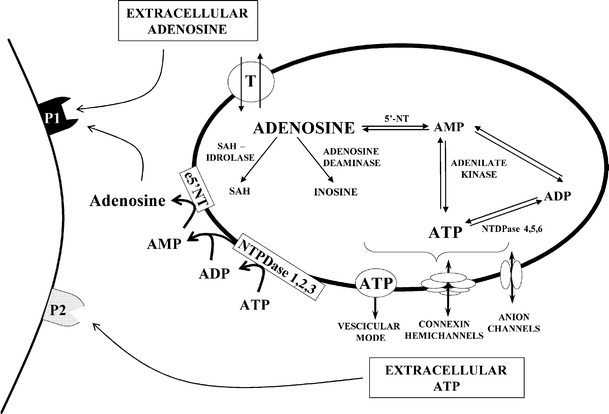
The adenosine deaminase gene can give you a deeper night’s sleep, but make you sleepier during the day. Learn how to raise & lower it here.
About Adenosine Deaminase (ADA)
Adenosine Deaminase or ADA converts adenosine to inosine. Inosine acts as a competitive inhibitor to adenosine.
Adenosine deaminase is present in places like red blood cells and the vessel wall [1].
There are two forms of ADA: ADA1 and ADA2.
ADA2 is the predominant form present in blood and is increased in many diseases, particularly those associated with the immune system: for example most cancers, rheumatoid arthritis, psoriasis and sarcoidosis [2].
In addition to adenosine breakdown, ADA is believed to stimulate the release of excitatory amino acids [2].
ADA is also necessary for the adenosine A1 receptors to work properly. A1 receptors are implicated in sleep promotion by inhibiting wake-promoting cholinergic neurons in the basal forebrain. Caffeine blocks these receptors [3].
Levels of ADA correlate with blood glucose (HbA1C) because adenosine increases insulin sensitivity – and higher ADA will lower adenosine [4].
The A1 receptors decrease cAMP [3]. Stimulation of the A1 receptor results in a decrease in heart rate [3].
ADA causes reduced telomerase activity [5].
About Adenosine
Adenosine is a chemical that’s a part of ATP and cAMP. It is believed to be sleep-promoting and suppresses arousal.
Adenosine can be converted to SAH and AMP [6].
Adenosine inhibits the activity of orexin neurons (by the A1 receptor in the lateral hypothalamus), which causes fatigue and allows for sleep [7].
Orexin A causes wakefulness and the sleep-promoting action of adenosine can be reversed by orexin A (applied to the lateral hypothalamus, perhaps by exciting glutamate input to orexin neurons via the action of orexin receptor 1) [8].
Caffeine’s principal mode of action is as an antagonist of adenosine receptors in the brain [1].
Adenosine increases blood flow to various organs through vasodilation [1].
Adenosine increases insulin sensitivity and glucose uptake in cells, which lowers blood glucose [4].
During instances of cellular stress such as inflammation or hypoxia, adenosine levels increase and (through A2A receptors) produce an overall anti-inflammatory effect [1].
Adenosine receptors are key in opening the blood-brain barrier (BBB). Mice dosed with adenosine have shown increased BBB permeability [9].
Adenosine activates ghrelin/growth hormone secretagogue receptor. Therefore, it’s able to increase appetite. However, it is unable to induce the secretion of growth hormone [1].
Adenosine is believed to be an anti-inflammatory agent at the A2A receptor, both internally and topically. It speeds wound healing [1].
Methotrexate’s anti-inflammatory effect may be due to its stimulation of adenosine release [1].
A reduction in adenosine activity leads to increased activity of dopamine and glutamate [1].
Adenosine has been shown to promote thickening of hair on people with thinning hair [1].
Adenosine increases slow wave sleep [10].
Adenosine inhibits prolactin and growth hormone secretion in pituitary cells [11].
However, adenosine is an agonist of the Growth Hormone Secretagogue Receptor [12], which means that it probably increases growth hormone release.
ADA, Adenosine, and The Immune System
ADA and adenosine in humans are both involved in the development and maintenance of the immune system [2].
Adenosine and ADA mainly have an immune lowering effect, but also have an immune stimulation effect in some ways.
ADA activates T lymphocytes [4].
Adenosine stimulates the immune system by triggering the release of IL-6 and IL-1b [5].
Adenosine inhibits the immune system by decreasing TNF, which is an inflammatory cytokine.
Adenosine also inhibits the activity of NK cells [5], which is important to control viral infections.
Adenosine deaminase deficiency is a known cause of immunodeficiency [1].
ADA deficiency increases thymus cell death [5], which will cause lower immune function as you age.
ADA inhibition causes a quicker depletion of CD8+ T lymphocytes as people age [5].
ADA causes less IL-2 production [5].
Deficient levels of ADA have also been associated with lung inflammation, thymus cell death, and defective T-cell receptor signaling [2].
The Adenosine Deaminase Gene
Check out SelfDecode to see what alleles you have.
ADA Gene SNPs:
How to Increase Adenosine Deaminase
If you have low ADA, you especially want to make sure you’re getting enough Zinc.
- Zinc is the only cofactor necessary for ADA activity, so adequate zinc is needed for the enzyme to work well [2].
- Estradiol is one of the few inducers of adenosine deaminase [13].
- IGF-1 is another inducer of adenosine deaminase [14].
- Simvastatin (and probably other statins) increases ADA production when it’s suppressed by IL-13 [15].
- Since low ADA will also lead to lower inosine, I recommend supplementing with 250-500mg inosine. Inosine will also compete with adenosine and balance you out more.
- Caffeine can play a beneficial role because it’s a PDE inhibitor and also an adenosine antagonist, but caffeine has negatives.
ADA Inhibitors
If you have the T allele, you want to be aware of ADA inhibitors.
- Progesterone [16]
- IL-13 [15]
- DPP4 inhibitors, one of which is berberine [4].
- Mercury [17]
- Curcumin inhibits ADA in rats exposed to cadmium [18].
- Nettle inhibits ADA in prostate cancer tissue [19].
- Nitric oxide increases adenosine.
If you want to interpret or analyze your genes, the best tool is SelfDecode.
SelfDecode is a sister company of SelfHacked. The proceeds from your purchase of this product are reinvested into our research and development, in order to serve you better. Thank you for your support.



